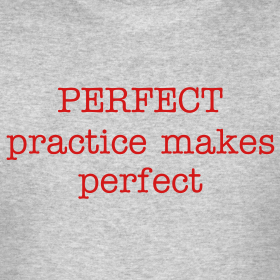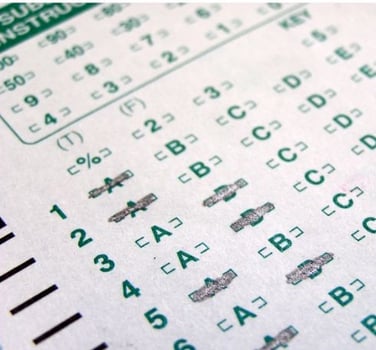
Want to prep for the ACT on you own? Chances are you’ve ordered a prep book to help you study.
One of the most popular prep books around is The Real ACT Prep Guide. But how can you make sure you get your money’s worth out of the book – and make sure you actually study well enough to improve your ACT composite? Read our guide to using The Real ACT Prep Guide to find out.
What’s in The Real ACT Prep Guide?
The Prep Guide has two main components: an overview of each section of the ACT (English, Math, Reading, Science, and optional essay) and 5 full-length practice tests.
The book is made by the ACT, so the practice tests are the best-quality ones you can get, which is why the book is so popular (at the time of writing, it’s the #1 best-selling ACT Test Guide on Amazon.com). This book can be an excellent resource if you’re trying to improve your ACT score.
However, there are ways to use it effectively and less effectively – we’ll show you how.
How to Use the Content Overview Section
The Real ACT Prep Guide contains a brief overview of each section on the ACT and the content you need to know for each. However, it doesn’t teach you the content.
For example, it will say you need to know basic trigonometric identities for the math section and give an example problem, but it won’t explain what those identities are. So if there is a concept you don’t know, The Real ACT Prep Guide won’t help you learn it.
Still, we advise you read through the content review so you know what you are being tested on.
If you come across content areas you’re fuzzy on – whether that’s plane geometry or grammar rules – you’ll need to find a more specific prep book or source to help you actually learn it.
Make a list of content areas (if any) that you’re shaky on as your read through the content review, and seek out other resources (like more specific prep books and websites) to learn them before embarking on the practice tests.
You also might check out our free detailed guides on ACT English, ACT Math, ACT Reading, ACT Science, and ACT Writing.
How to Use the 5 ACT Practice Tests
These five practice tests are the main reason people go for The Real ACT Prep Guide. Since the tests are written by the test-makers themselves, they give you some of the best quality practice for the ACT you can get.
However, if you go through the tests without a strategy, or without adequately checking your answers, you’ll waste them. Taking the tests alone will not help you get a higher ACT score. Point improvements can only come if you identify your weaknesses and drill them until they’re gone.

By "perfect practice," we don't mean you should already be getting perfect scores on your practice tests. We mean treating the practice tests like real ones, and then taking adequate time to correct them and understand your mistakes.
With that in mind, here’s how to make the most of the practice tests.
Timing
If you tend to run out of time on ACT sections, you can experiment with giving yourself time and a half, time and a quarter, and then strict timing on the practice tests, to build up your speed. (If you ever run out of time on a section, by the way, still answer the rest of the questions after you’re done with the test to maximize your knowledge-building.)
In any case, be careful to time yourself strictly for each practice test, even if you’re starting with time-and-a-half. You’ll be the most prepared for the ACT if you’re able to deal with both the pacing and content.
Wear a watch when you practice so you can get use to monitoring your time per question. You won’t be able to bring your phone with you to the test, so get used to using a more old-fashioned timer.
Read more about ACT timing for more tips on timing (including the approximate time you have for each question).
Stamina
If you’re worried about getting through the whole test with enough energy and focus, make sure to take at least some of the practice tests in full blocks, as if you were taking the real ACT, with strict timing throughout.
This will help you build your stamina so that on test day, you will have just as much energy on the Science section (which comes last) as you do on the English section (which comes first).
If you have no problem with getting through long tests, and you have one particular section giving you trouble, you could focus on just that section and drill it.
For example, say that you consistently score 32 and higher when you practice English, Reading, and Science, but are struggling to break 28 on the Math section. You may want to do more practice Math sections to make up for the discrepancy.
However, keep in mind any time you take a section by itself, you won’t be able to use that practice test for a complete run-through. Don’t break up all five of the practice tests into their sections. Keep at least two for full run-throughs.
Checking Answers
When checking the answers on your practice tests, don’t just correct your multiple-choice sheet, tally a score, and wait to see improvement. Rushing through the tests won’t help you get any better.

First of all, as you move through the test, mark any questions you are unsure about. This way, even if you get them right, you can examine why they were right and what prevented you from being sure.
Next, look at what you got wrong. Figure out the skill, concept, or line of reasoning you didn’t have that prevented you from getting it right. For example, did you miss that reading question because you didn’t know the meaning of a word, or because you misunderstood the context of the passage?
Also refer to the answer explanations the Real ACT Guide provides, but keep in mind that can be a bit shallow (“A is wrong because it is. B is right because…”).
Finally, log your mistakes in a notebook. This way you can begin to notice any patterns or consistent gaps in your knowledge.
For example, when correcting the math section and logging your mistakes, you might find you missed three questions because you weren’t able to figure out plane geometry and seven questions because you made silly arithmetic errors (like forgetting a negative sign).
By logging your mistakes and their causes, you will have a ready-made study guide to use in between practice tests. You can go right to the heart of your weaknesses and drill them.
What To Do In Between Tests
Don’t just jump from practice test to practice test without studying in between. That would be like a marathon runner jogging 26 miles every day instead of training in intervals – they would horribly injure themselves and not improve at all.
While you likely won’t injure yourself from taking five ACT practice tests in a row (though your hand may cramp up pretty badly), you will lose the opportunity to learn from your mistakes and improve.
Using your notebook of mistakes, go back to your other resources – the Real ACT content guide chapters, other prep books, the internet – to learn content you still don’t know and practice specific problems.
This is also the time to develop and try new strategies. For example, say you keep running out of time on Science because you read the passages first then go to the questions.
You might test out starting with the questions and seeing if that improves your time while maintaining accuracy while working through smaller blocks of practice problems.
Only once you’re feeling confident about your progress should you attempt the next practice test.
The Study Regimen You Should Follow

By following the principles above, you can make the most out of the practice tests in The Real ACT Prep Guide. But you may be asking how often you should take practice tests, and what your study schedule should be like.
We suggest, before you start studying, you take a full-length practice test. From your performance, figure out your weaknesses in each section. Find resources to improve your weaknesses, and also read through The Real ACT Prep Guide's content review.
Depending on when your ACT test date is, take another practice test after two or three weeks of studying. This way you can give yourself adequate time to study and improve. Carefully analyze the results of your second practice test to see where you still need work.
You can repeat this process as many times as you need. As you get closer to the test and you correct more of your weaknesses, you can shorten your time between practice tests. Keep studying until you feel confident you will hit your target score on test day.
What Happens If I Run Out of Practice Tests?
Unlike the SAT’s Official Guide, which has 10 (!) practice tests, ACT only gives you five in The Real ACT Prep Guide. For many students, this is more than enough.
But it’s likely, especially if you’re a high-achieving student, you may run out of practice tests before you feel ready for the ACT – especially if you’re going for a 33 or higher.
In that case, check out our links to free ACT practice tests online. These don’t come with answer explanations, so save them for after you’ve done the five Real ACT ones so you’ll be more skillful at identifying your mistakes anyway.
What’s Next?
What other principles should you be keeping in mind as you study for the ACT? Check out our guide to a perfect 36 by our resident full-scorer. Even if you’re not going for a 36, these study principles show you how to make the most of your time studying for the ACT, including the best way to analyze your mistakes.
Want more background on the ACT? Get a guide to ACT timing, as well as what’s on each section (English, Math, Reading, Science).
Wondering why you keep running out of time on your practice tests? Get in-depth guides for finishing the Math and Reading sections on time.
Want to improve your ACT score by 4+ points? Download our free guide to the top 5 strategies you need in your prep to improve your ACT score dramatically.
These recommendations are based solely on our knowledge and experience. If you purchase an item through one of our links, PrepScholar may receive a commission.
Have friends who also need help with test prep? Share this article!

Halle Edwards graduated from Stanford University with honors. In high school, she earned 99th percentile ACT scores as well as 99th percentile scores on SAT subject tests. She also took nine AP classes, earning a perfect score of 5 on seven AP tests. As a graduate of a large public high school who tackled the college admission process largely on her own, she is passionate about helping high school students from different backgrounds get the knowledge they need to be successful in the college admissions process.


































 Holly R.
Holly R.